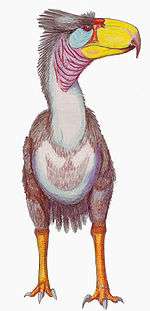Titanis
| Titanis Temporal range: Blancan-Gelasian,[1] 4.9–1.8 Ma | |
|---|---|
 | |
| Reconstructed skeleton, Florida Museum of Natural History | |
| Scientific classification | |
| Kingdom: | Animalia |
| Phylum: | Chordata |
| Class: | Aves |
| Order: | Cariamiformes |
| Family: | †Phorusrhacidae |
| Subfamily: | †Phorusrhacinae |
| Genus: | †Titanis Brodkorb, 1963 |
| Type species | |
| †Titanis walleri Brodkorb, 1963 | |
Titanis walleri is a large extinct flightless carnivorous bird of the family Phorusrhacidae, endemic to North America during the Blancan stage of the Pliocene living 4.9—1.8 Ma, and died out during the Gelasian Age of the earliest Pleistocene, existing approximately 3.1 million years.[2] It was 2.5 metres (8.2 ft) tall and weighed approximately 150 kilograms (330 lb).
Etymology

The generic name, Titanis, refers to the titans, Ancient Greek gods that preceded the Twelve Olympians, in allusion to the bird's size. The specific name, T. walleri, honors the holotype's collector, Benjamin I. Waller.
Origin
It lived approximately 5-2 million years ago (early Pliocene to early Pleistocene) in North America. Fossil evidence has been found in Gilchrist County, Florida dating from 3.0 to 2.9 million years.[3]
From circumstantial evidence (i.e., bone fractures), it has been suggested that the species did not become extinct until 15,000 years ago,[4] but more precise dating by McFadden and colleagues refutes such a late date; all known Titanis fossils appear to be at least 2 million years old.[1][5] Titanis was part of the group of giant flightless birds called the Phorusrhacidae, which are nicknamed "terror birds", and has been thought to represent the youngest species of the lineage (recently, a significantly younger South American example has been reported[6]). The Phorusrhacidae originated in South America; Titanis is the only known member of the branch of the group that migrated out of that continent during the Great American Interchange.
A lineage of related predatory birds, the bathornithids, occurred in North America from the Paleocene to the Miocene. They were not ancestral to Titanis or any other phorusrhacid, but they occupied similar ecological niches and some like Paracrax even attained similar sizes, reaching above 2 meters in height. They became extinct more or less 15 million years before Titanis reached North America.[7]
Morphology

It was 2.5 metres (8.2 ft) tall and weighed approximately 150 kilograms (330 lb), but with large variance (perhaps indicating strong sexual dimorphism).[8] Though its skull has not been found, it most probably would have been large, with a huge, axe-like beak, like its relatives.
It is estimated that Titanis could run at speeds of 65 km/h.
The wings were small and could not have been used for flight. The wing bones articulated in an unusual joint-like structure, suggesting the digits could flex to some degree. It also had a relatively rigid wrist, which would not have allowed the hand to fold back against the arm to the same degree as other birds. This led R.M. Chandler to suggest that the wings may have supported some type of clawed, mobile hand similar to the hands of non-avian theropod dinosaurs, such as the Dromaeosaurs (also popularly known as "raptors").[9] However, it was later pointed out that this wing joint is not in fact unique, and is present in seriemas (extant members of the same order, Cariamae, to which Titanis and other phorusrhacids belonged), which do not have any specialized grasping hands.[10]
Overall, Titanis was very similar to the South American Phorusrhacos and Devincenzia, its closest relatives. However, it differs from these in having a shorter, thicker neck, a bulkier head, and an overall more heavily built bodily structure. Little is known of its body structure, but it seems to have been less wide-footed than Devincenzia, with a proportionally much stronger middle toe.[11]
References
- 1 2 MacFadden, Bruce J.; Labs-Hochstein, Joann; Hulbert, Richard C.; Baskin, Jon A. (2007). "Revised age of the late Neogene terror bird (Titanis) in North America during the Great American Interchange" (PDF). Geology. 35 (2): 123–126. doi:10.1130/G23186A.1.
- ↑ Marsh, O. C. (1875). "On the Odontornithes, or birds with teeth". American Journal of Science. 10: 403–408. JSTOR 2448315.
- ↑ Alroy, John, Ph.D. Synonymies and reidentifications of North American fossil mammals, 2002. John P. Hunter, Ohio State University, Mammalian Paleontology.
- ↑ Baskin, J. A. (1995). "The giant flightless bird Titanis walleri (Aves: Phorusrhacidae) from the Pleistocene coastal plain of South Texas". Journal of Vertebrate Paleontology. 15 (4): 842–844. doi:10.1080/02724634.1995.10011266.
- ↑ McFadden, B.; Labs-Hochstein, J.; Hulbert, Jr., R. C.; Baskin, J. A. (2006). "Refined age of the late Neogene terror bird (Titanis) from Florida and Texas using rare earth elements" (PDF). Journal of Vertebrate Paleontology. 26 (3): 92A (Supplement). doi:10.1080/02724634.2006.10010069.
- ↑ Alvarenga, H.; Jones, W.; Rinderknecht, A. (2010-05-01). "The youngest record of phorusrhacid birds (Aves, Phorusrhacidae) from the late Pleistocene of Uruguay". Neues Jahrbuch für Geologie und Paläontologie – Abhandlungen. 256 (2): 229–234. doi:10.1127/0077-7749/2010/0052.
- ↑ Cracraft, Joel, A review of the Bathornithidae (Aves, Gruiformes), with remarks on the relationships of the suborder Cariamae. American Museum novitates ; no. 2326
- ↑ Alvarenga, H. M. F.; Höfling, E. (2003). "Systematic revision of the Phorusrhacidae (Aves: Ralliformes)". Papéis Avulsos de Zoologia. 43 (4): 55–91. doi:10.1590/S0031-10492003000400001.
- ↑ Chandler, R.M. (1994). "The wing of Titanis walleri (Aves: Phorusrhacidae) from the Late Blancan of Florida". Bulletin of the Florida Museum of Natural History, Biological Sciences. 36: 175–180.
- ↑ Gould, G.C. & Quitmyer, I.R. (2005). "Titanis walleri: bones of contention" (PDF). Bulletin of the Florida Museum of Natural History. 45: 201–229.
- ↑ Brodkorb, P. (1963). "A giant flightless bird from the Pleistocene of Florida" (PDF). Auk. 80 (2): 111–115. doi:10.2307/4082556.
External links
- dinosoria.com: Titanis walleri reconstructions. Retrieved 2007-FEB-09.
- Bryner, Jeanna (2007-01-23). "Huge, Terrifying Carnivorous Bird Invaded North America Long Ago". Fox News.
- Discover Magazine, June 1997: Terror Take Two